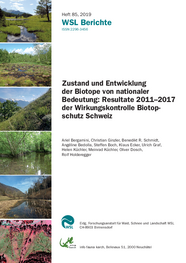Zustand und Entwicklung der Biotope von nationaler Bedeutung: Resultate 2011–2017 der Wirkungskontrolle Biotopschutz Schweiz

Authors:
Ariel Bergamini, Christian Ginzler, Benedikt R. Schmidt, Angéline Bedolla, Steffen Boch, Klaus Ecker, Ulrich Graf, Helen Küchler, Meinrad Küchler, Oliver Dosch, Rolf Holderegger
Series:
WSL Berichte
85
Publishing year:
2019
Amount:
104 Pages
Download
Quote:
Bergamini A., Ginzler C., Schmidt B.R., Bedolla A., Boch S., Ecker K., … Holderegger R. (2019) Zustand und Entwicklung der Biotope von nationaler Bedeutung: Resultate 2011–2017 der Wirkungskontrolle Biotopschutz Schweiz. WSL Berichte 85. Birmensdorf: Eidg. Forschungsanstalt für Wald, Schnee und Landschaft WSL. 104 S.
Available languages:
